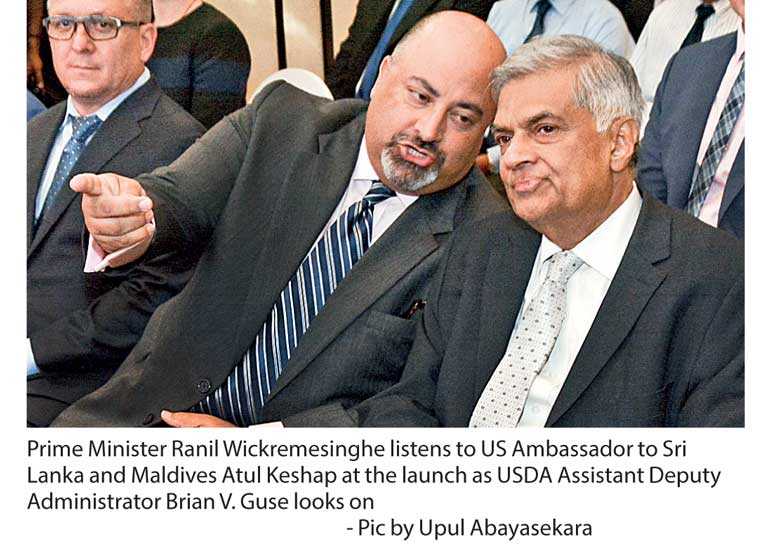Friday Nov 15, 2024
Friday Nov 15, 2024
Friday, 18 May 2018 00:00 - - {{hitsCtrl.values.hits}}

By Divya Thotawatte
A Rs. 2 billion initiative to double Sri Lanka’s dairy production kicked off yesterday with Prime Minister Ranil Wickremesinghe outlining ambitious plans to use the project to improve quality and strengthen the rural economy.
The new project is a joint venture between the Sri Lankan Government and the United States Department of Agriculture. Titled the ‘Market Oriented Dairy Project’, it aims to expand the country’s dairy industry by increasing productivity and introducing higher quality products to meet local demand. The project, which will run for four and a half years, will be implemented by the US-based International Executive Service Corps.
“The main objective is to empower small-scale and middle-scale dairy farmers to improve their productions and productivity by providing knowledge and technology transfer and facilitating investment. This is important as currently we obtain only five litres of milk from one cow. That is too little. So we’re trying to improve the productivity and bring it up to 10 litres. I think our final objective should be to quadruple production. Even though we say five litres that is actually from suppliers of the best companies manufacturing the highest quality products but for small and medium-scale famers the yield is much less. We have to change this,” said Wickremesinghe.
Dairy is considered to be one of the most important subsectors of the local livestock industry but local milk production only meets about 30%-40% of demand. Enhancing productivity and overall industry competitiveness would allow farmers to increase their income and for Sri Lanka to save significant amounts of foreign exchange.
The Prime Minister was also upbeat about the Government’s renewed focus on expanding agriculture-related industries pointing out that they had begun an effort to empower local primary industries to increase exports as that would benefit farming communities in rural areas. The dairy project would also similarly encourage new ventures and industry expansion at the grassroots level that would lead to stronger economic growth.
Agriculture currently accounts for about 7% of Sri Lanka’s Gross Domestic Product (GDP) but employs about 27% of its labour force. A large segment of this population is rural and the Government is attempting to increase productivity by introducing new technology and market linkages to these communities.
“This is the largest American-funded dairy project in Sri Lanka’s history. The United States Embassy in Colombo and the United States Department of Agriculture are very proud of the role that we play in working with countries all around the world to improve global and regional trade. Since 1956 the US has been privileged to help in the development of Sri Lanka,” said US Ambassador to Sri Lanka, Atul Keshap.
The project will enhance the capabilities of Sri Lanka’s dairy farmers and partners and is intended to lead to an average annual growth of 18% in milk production by 2022.
During the course of the four-year project, milk production is expected to grow by 94% overall. Strengthening the dairy sector will also contribute significantly towards the national initiative of reaching self-sufficiency in dairy production.
Approximately 80% of the beneficiary farmers will receive a quality-based price premium for their milk. Additionally, participants will receive training to help them create sustainable and profitable businesses. The project will also facilitate financing and investment opportunities and provide support to the newly created All Island Dairy Association under the aegis of the Ceylon Chamber of Commerce.
The program will attempt to increase productivity to meet local demand which Project Director Matthew Krause said was growing by 10% annually. The project would also upgrade farms, collection centers and processing units as well as encouraging and facilitating investments in the dairy sector.
“In consultation with the Government, private sector companies, industry experts, dairy farmers, the project is designed to be responsive to local situations and needs. The Market Oriented Dairy project focuses on less cows and more milk.”